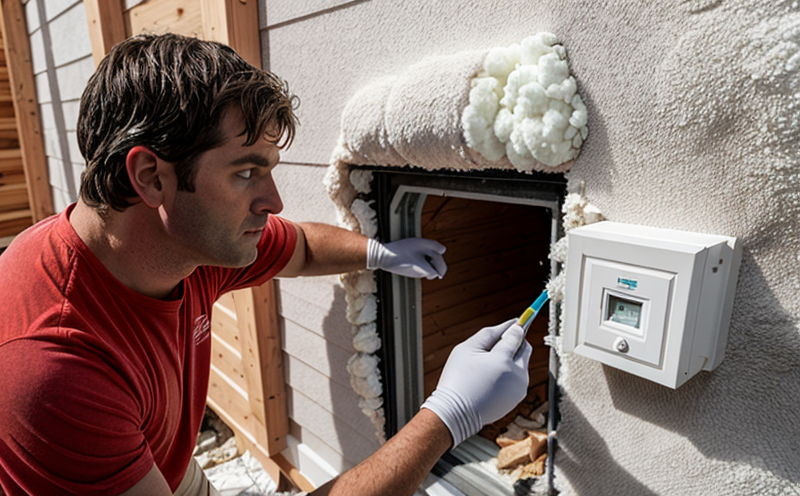ASTM C177 Guarded Hot Plate Conductivity Test
The ASTM C177 Guarded Hot Plate (GHP) test is a standardized procedure used to measure the thermal conductivity of insulating materials. This method is particularly important for ensuring that building and infrastructure materials meet specified performance standards, especially in relation to their thermal properties.
During this test, a specimen of the material under examination is placed between two hot plates. One plate remains at a constant temperature while the other gradually heats up. The difference in temperature between these plates creates a steady heat flux through the sample. By measuring the amount of heat that passes through the specimen and knowing the dimensions and thickness of the test piece, it is possible to calculate its thermal conductivity.
This testing method is widely recognized for its accuracy and reliability across various sectors including building construction, insulation manufacturing, and HVAC (Heating, Ventilation, and Air Conditioning) systems design. It enables quality managers, compliance officers, R&D engineers, and procurement teams to verify that the materials they select or produce meet stringent thermal performance criteria.
The GHP test provides a quantitative measure of how effectively an insulating material can prevent heat flow. This information is crucial for designing energy-efficient buildings, optimizing insulation usage, and ensuring long-term durability. By applying this standard test, stakeholders in the building & infrastructure sector can make informed decisions about which materials to use based on their thermal performance.
Accurate measurement of thermal conductivity helps reduce energy consumption, lower operational costs, enhance occupant comfort, and contribute positively towards environmental sustainability goals. Compliance with international standards such as ASTM C177 ensures consistency across industries and supports global efforts aimed at reducing carbon footprints associated with buildings and construction projects.
Why It Matters
The importance of accurate thermal conductivity testing cannot be overstated, especially within the context of building & infrastructure testing. Insulation materials play a critical role in determining the overall energy efficiency and environmental impact of buildings and structures.
- Energy Efficiency: Properly insulated buildings require less heating or cooling, thereby reducing energy consumption and associated greenhouse gas emissions.
- Cost Savings: Efficient insulation can lead to significant reductions in utility bills over time.
- Comfort: Well-insulated environments maintain more stable temperatures, leading to improved occupant comfort.
- Sustainability: By using materials that perform well according to ASTM C177, construction professionals contribute to a greener built environment. This aligns with broader global initiatives focused on minimizing environmental footprints.
In addition to these benefits, adhering to recognized standards like ASTM C177 helps ensure consistency and comparability in testing results. This fosters trust among stakeholders and supports fair competition within the industry.
Environmental and Sustainability Contributions
The ASTM C177 GHP test contributes to environmental sustainability by providing precise data on a material’s ability to insulate effectively. This information is vital for architects, engineers, and builders who aim to construct sustainable structures that minimize energy usage and reduce carbon emissions.
- Reduction in Energy Consumption: By selecting insulation materials with high thermal resistance as determined by ASTM C177 testing, buildings consume less electricity or natural gas for heating and cooling purposes.
- Decreased Operational Costs: Lower energy bills result from reduced heating and cooling needs, benefiting both residential properties and commercial facilities.
- Better Indoor Air Quality: Properly insulated spaces maintain consistent temperatures without excessive fluctuations, which can help reduce the need for mechanical ventilation systems. This reduces the introduction of outdoor pollutants into indoor environments.
The ASTM C177 test is just one aspect of comprehensive building performance evaluation that focuses on creating structures that are energy-efficient and environmentally responsible.
Use Cases and Application Examples
| Application Example | Description |
|---|---|
| Residential Construction | Ensuring that homes meet local energy efficiency codes by verifying insulation performance. |
| Commercial Buildings | Selecting appropriate materials for large-scale projects like office complexes or retail spaces to optimize heating and cooling systems. |
- Manufacturing Facilities: Guaranteeing that industrial plants have adequate insulation to prevent heat loss, which can improve productivity by maintaining optimal working conditions inside factories.
- Hospitals and Schools: Ensuring educational institutions and healthcare facilities operate efficiently with minimal energy waste while providing comfortable learning/study environments for students and patients alike.
These examples illustrate how ASTM C177 testing is applicable across different sectors, helping to drive improvements in thermal performance within diverse applications.





